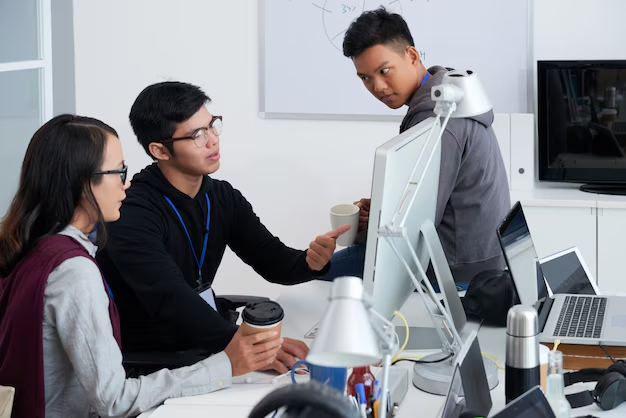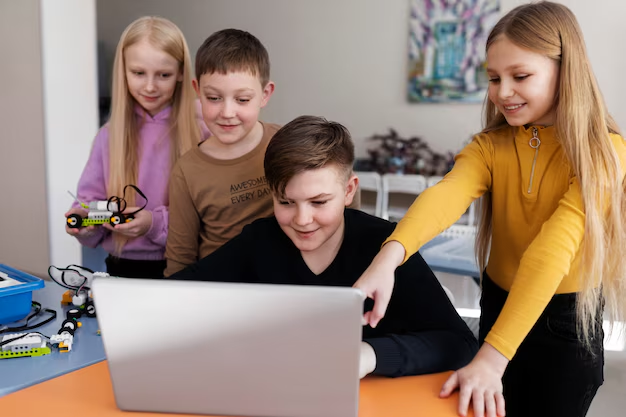The future of robotics in education is poised to revolutionize how students learn, teachers instruct, and educational institutions operate. Robotics technology, already reshaping industries such as healthcare, manufacturing, and transportation, is now making significant strides in education and learning. From enhancing STEM education to offering personalized learning experiences, robotics in education is becoming a pivotal tool for preparing students for the future. In this article, we explore the exciting potential of robotics in education and the transformative impact it will have on learning environments.
1. Enhancing STEM Education
One of the most prominent ways robotics is shaping the future of education is through its integration into STEM (Science, Technology, Engineering, and Mathematics) education. Robotics encourages students to engage with practical applications of STEM concepts, enhancing their understanding of these subjects.
- Interactive Learning: Robots enable hands-on learning experiences, allowing students to program, build, and control robots, which reinforces theoretical knowledge.
- Problem-Solving Skills: By working with robots, students develop crucial skills such as critical thinking, problem-solving, and creativity.
- Engagement and Motivation: Robots make learning interactive and fun, keeping students engaged and motivated to explore STEM subjects further.
These advantages make robotics an essential part of STEM curricula, empowering students to develop valuable skills for future careers in technology, engineering, and innovation.
2. Personalized Learning and Adaptive Systems
Robotics in education can also facilitate personalized learning experiences. Robotic systems, paired with artificial intelligence (AI), can tailor educational content to meet the individual needs of students, allowing for a more customized learning experience.
- Adaptive Learning Technologies: Robots can assess each student’s progress and adapt the lessons accordingly, providing additional support for struggling students or more advanced material for those excelling.
- Individualized Attention: In a classroom with many students, robots can offer one-on-one assistance to students, ensuring that each learner receives the attention they need.
- Real-Time Feedback: Robots can provide instant feedback on assignments, helping students understand their strengths and areas for improvement.
These personalized learning experiences can help students progress at their own pace, promoting deeper learning and better retention of knowledge.
3. Robots as Teaching Assistants

In the classroom of the future, robots are set to become an integral part of teaching teams. While robots cannot replace human educators, they can act as teaching assistants, providing valuable support to teachers.
- Administrative Assistance: Robots can handle administrative tasks, such as grading assignments or managing classroom materials, giving teachers more time to focus on instruction.
- Facilitating Collaborative Learning: Robots can engage students in collaborative learning activities, helping them work together on projects or tasks, which fosters teamwork and communication skills.
- Language Learning: Robots can assist in language learning, providing interactive conversation practice and supporting students in mastering new languages.
By automating routine tasks and facilitating interaction, robots can enhance the teaching experience for both educators and students.
4. Inclusive Education for Special Needs Students
Robotics offers exciting potential for inclusive education, particularly for students with special needs. Robots can be designed to provide tailored educational experiences for students with disabilities, helping them engage in learning in a way that suits their abilities.
- Assistive Technology: Robots can be equipped with tools that help students with physical disabilities perform tasks or participate in classroom activities.
- Social and Communication Skills: Robots can aid students with autism or other social challenges by encouraging interaction, communication, and social engagement.
- Motivation and Engagement: Robots’ interactive nature can motivate students with special needs to stay engaged in learning, making education more accessible and enjoyable.
With the help of robots, special needs students can receive the support they need to thrive academically and socially.
5. Virtual and Augmented Reality Integration
The integration of virtual reality (VR) and augmented reality (AR) into robotics is creating immersive learning environments that enhance educational experiences. With VR and AR, students can interact with 3D models, simulations, and virtual environments that enhance understanding.
- Immersive Learning: Students can explore historical events, visit far-off places, or conduct scientific experiments—all from the classroom.
- Interactive Simulations: Robotics can bring simulations to life, allowing students to interact with complex systems, such as human anatomy or geological processes, in a dynamic and engaging way.
- Enhanced Collaboration: VR and AR environments foster collaboration between students, teachers, and even peers around the world, offering opportunities for cross-cultural learning.
The combination of robotics, VR, and AR creates exciting possibilities for hands-on, immersive learning that was previously unimaginable.
6. Preparing Students for Future Careers
As robotics technology continues to evolve, students must be prepared to work with robots in various industries. Robotics in education helps students develop skills in robot programming, coding, and engineering, preparing them for careers in fields like automation, artificial intelligence, and data science.
- Workforce Readiness: By learning to design, build, and program robots, students acquire skills that will be highly sought after in the job market.
- Early Exposure to Technology: Introducing students to robotics at an early age encourages interest in STEM careers and fosters a lifelong passion for technology.
- Career Pathways: Robotics education provides pathways for students to pursue further studies or vocational training in robotics engineering, AI development, and other tech fields.
By integrating robotics into the curriculum, educators help equip students with the skills needed to succeed in a technology-driven world.
7. The Role of Robotics in Teacher Training and Professional Development
Robotics will also play a significant role in teacher training and professional development. Educators can use robots to enhance their own teaching methods and stay up to date with the latest technological advancements in education.
- Teaching New Skills: Teachers can be trained to integrate robotics into their classrooms, improving their ability to teach students how to work with emerging technologies.
- Collaborative Training: Teachers can use robotic systems to collaborate with peers, share ideas, and experiment with new teaching techniques.
- Professional Growth: Continuous professional development in robotics will help educators stay ahead of educational trends and enhance their instructional capabilities.
By fostering an understanding of robotics, teachers are better equipped to teach students in a future-focused classroom environment.
8. The Future of Robotics in Education
The possibilities for robotics in education are endless. As technology continues to advance, we can expect even more innovative applications in classrooms around the world.
- Fully Autonomous Classrooms: In the future, robots may be able to teach entire classes autonomously, providing personalized education at scale.
- Robot-Led Learning Environments: Robots may facilitate interactive learning experiences, allowing students to learn at their own pace while receiving real-time feedback and guidance.
- Global Learning Communities: Robotics can connect students from around the world, enabling them to collaborate and learn from each other in virtual environments.
The integration of robotics into education is just beginning, and the potential for transformation is immense.
Also Read : What Are The Key Benefits Of Robotics In Healthcare?
Conclusion: The Future of Robotics in Education
The future of robotics in education is both exciting and transformative. Robotics has the potential to enhance learning outcomes, engage students in new ways, and prepare them for the future workforce. By integrating robotics into classrooms, educational institutions can create innovative learning environments that foster creativity, critical thinking, and collaboration. As technology continues to evolve, robotics will play an increasingly important role in shaping the education system and empowering students to succeed in the 21st century.
SEO Optimized Keywords:
- Robotics in education
- Future of robotics in education
- Benefits of robotics in learning
- Robotics in classrooms
- STEM education with robotics
- Personalized learning with robotics
- AI and robotics in education
- Robotics for special needs students
- Virtual reality in education
- Robotics in teacher training
- Educational robotics systems
- Robotics for hands-on learning
- Future career preparation with robotics
- Robotics in K-12 education
- Robotic learning assistants
- Robotics programming for students
- Robotics in special education
- Interactive learning with robotics
- Robots in STEM education
- Technology in education
- Robots in teacher development
- Robotics and personalized learning
- Future of STEM education
- Robots in inclusive education
- Robotics for critical thinking development
- Robotics and AR/VR in education

